Some understanding of the reality of the insect will help. The beetle's back is a hard shell divided into several segments - head, thorax and forewings. The underside is iridescent. The hind wings, which are used for flying, are also iridescent and transparent. At rest, they are hidden under the forewings, which are lifted up in flight to give the hind wings free play. The legs are broad and toothed, for digging.
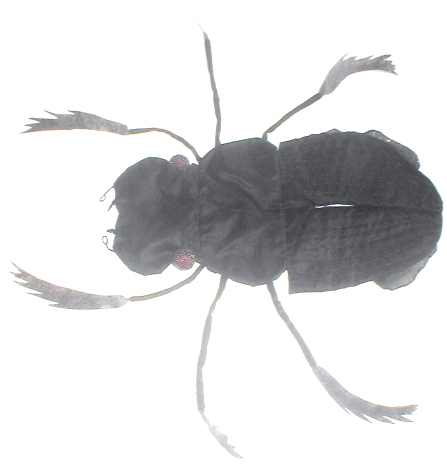
The obvious material for the beetle's back is black satin, the shinier the better. All the pieces have wired edges, and the forewings, which in display have to be visible from their undersides, are quilted and lined.
The legs are made from wire covered with the same satin, with "feet" of painted Lutradur attached. The legs are made in pairs, and stitched to the inside of the thorax. The jaws and antennae are made from thread-wrapped wire and stitched to the inside of the head. The eyes are stitched into the sides of the head.
The hind wings are also stitched to the inside of the thorax.
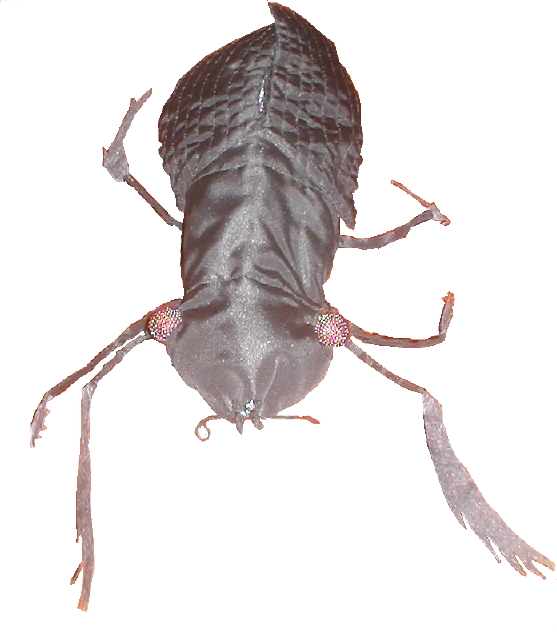
The beetle's body is made from a roll of craft vilene padded and covered with organza. Its outer covering is two "socks" knitted in Goldfingering - a longer one for the abdomen and a shorter one for the head end. The join between the two is covered with fabric.
The black satin shell is curved over this and stitched in place.
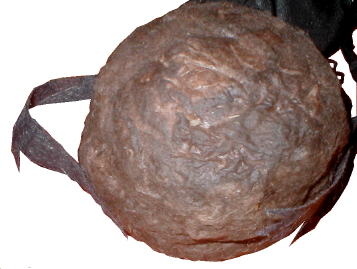
A dung beetle is recognised by its associated ball of dung, so obviously it had to be carrying one, even though in reality it would not do so in flight. (Aristophanes might not have bothered with the dung, since he had made ample verbal reference to it before the beetle arrived on stage, but fantasy has to be more pedantic.) The ball is hollow, so not as heavy as it seems. It is stitched to the front of the beetle's head and the front legs. It is made from silk cocoon strippings, coloured with Dye-na-flow and stiffened with PVA. It is made from two pieces using a mould (a plastic shape which, so far as I remember, originally supported a beef tomato!) The two pieces are fixed together with a further layer of strippings once they have dried.

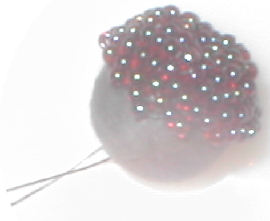
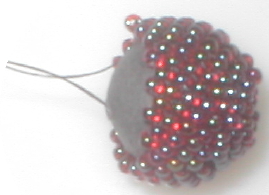
The multi-faceted insect eye is made using a compressed paper bead as foundation over which small glass beads are worked in a rather irregular version of brick stitch. The first picture shows the first eye finished, and a foundation bead for the second, painted black to harmonise with the rest of the head. I started with a small cluster of beads over the central hole of the foundation. Each row had to be increased rapidly to follow the curve of the foundation up to the centre then decreased again towards the end. The ends of the beading thread (black Nymo) are run through the central hole of the foundation bead and then used to secure the compound eye to the insect's head.
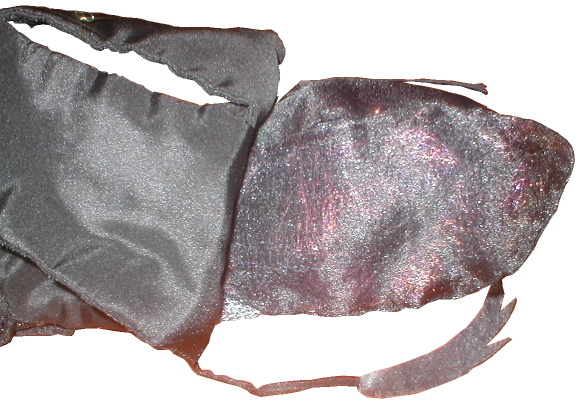
The wing is made from a layer of Angelina in mixed colours, sandwiched between two layers of black organza. The outline of the wind is made from fine wire (item AC1 from Habu Textiles) and the fabric is stitched over this. Surplus fabric is then cut away with the soldering iron. The wing has a forward extension (not present in nature) which is stitched to the underside of the shell so as to allow free movement of the wing itself.

Those who know Athens are probably aware of the Theatre of Dionysius. Unfortunately, what we can see now is much more recent than what was there when the play was performed (421 BC). Certainly, this is open-air theatre. We think that there was a fairly low stage with a house front behind. It was possible to have actors on the house roof, and the structure seems to have been substantial enough to support a crane. We know that the crane had been invented before this play (it was being used to build temples). If one could as a matter of routine lift large blocks of stone, then one could certainly lift the beetle and the actor, and move it about. Indeed, Euripides (tragic dramatist guyed in the second line of the excerpt below) has Medea in a chariot drawn by dragons with the dead bodies of her sons, so Aristophanes was not making difficult technical demands, though one imagines the movements required in comedy are more extreme than in tragedy (or temple building).
Even those without Greek may appreciate that the form of the lines (the metre) changes for the flight itself, and may realise that there are no stage directions. So visualisation is a problem for our fantasy. Sometimes the text is telling us what to imagine (because it cannot be represented); sometimes it accompanies what is (perhaps) being represented. It is a truth too easily ignored that comedy is funny; but we may not get the joke. Fortunately, the humour of the dung beetle is simple and gross. The flight ends with an appeal by the actor to the machine operator to be careful (three lines from the end of the excerpt), a jump out of the "suspension of disbelief".
I did consider including the actor on the beetle, but an accurate representation would have been, by modern tastes, obscene. Aristophanes had to get the beetle off stage (without the actor) at the end of the flight, and a second use of the crane might have been the easiest way of doing this.
The following translation (Benjamin Bickley Rogers) reflects the original metre, but there was never any rhyme in Greek poetry. Greek comedy was always scatological. Rogers is an honest translator, and does not hide this, but somehow contrives to make it charming.
Girl. Yet, O be careful lest you tumble off,
And (lame for life) afford Euripides
A subject, and become a tragic hero.
Tryg. I'll see to that : goodbye, goodbye, my dears !
But you, for whom I toil and labour so,
Do for three days resist the calls of nature ;
Since, if my beetle in the air should smell it,
He'll toss me headlong off, and turn to graze.
Up, up, my Pegasus, merrily, cheerily,
With ears complacent, while blithe and bold
Your curbs shake out their clatter of gold.
(I wonder what in the world he means
By pointing his nose at those foul latrines.)
Rise, gallantly rise, from the earth to the skies,
And on with the beat of your pinion fleet
Till you come to Zeus in his heavenly seat.
From all your earthly supplies of dirt,
From ordure and muck your nostril avert.
Man ! man in Peiraeus ! you'll kill me I swear,
Committing a nuisance ! good fellow, forbear ;
Dig it down in the ground, scatter perfumes around,
Heap, heap up the earth on the top,
Plant sweet-smelling thyme to encircle the mound,
Bring myrrh on its summit to drop ;
For 'if I through your folly shall tumble to-day,
And my enterprise fail to succeed in,
Five talents the city of Chios shall pay
On account of your breach — of good-breeding.
Zounds ! how you scared me : I'm not joking now.
I say, scene-shifter, have a care of me.
You gave me quite a turn; and if you don't
Take care, I'm certain I shall feed my beetle.